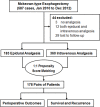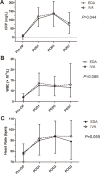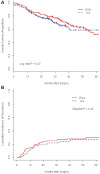Short and Long-Term Outcomes of Epidural or Intravenous Analgesia after Esophagectomy: A Propensity-Matched Cohort Study
- PMID: 27110939
- PMCID: PMC4844138
- DOI: 10.1371/journal.pone.0154380
Short and Long-Term Outcomes of Epidural or Intravenous Analgesia after Esophagectomy: A Propensity-Matched Cohort Study
Abstract
Background and objectives: As a well-established technique for postoperative pain relief, the benefits of epidural analgesia (EDA) have been under debate recently. This study aimed to determine whether EDA could improve perioperative outcomes and survival in patients undergoing esophagectomy.
Methods: From January 2010 to December 2012, 587 consecutive cases undergoing McKeown-type esohpageactomy were retrospectively identified from a prospectively maintained database.
Results: After propensity-matching, incorporating baseline characteristics, 178 cases were included in each group, and patients characteristics distributions were well-balanced between two groups. Compared with intravenous analgesia, the use of EDA significantly decreased the incidence of pneumonia from 32% to 19.7% (P = 0.008), and anastomotic leakage from 23.0% to 14.0% (P = 0.029). The change in CRP level of EDA group was significantly decreased (preoperative, 6.2 vs. 6.2; POD 1, 108.1 vs. 121.3; POD 3, 131.5 vs. 137.8; POD 7, 69.3 vs. 82.1 mg/L; P = 0.044). EDA patients had a significantly longer duration of indwelling urinary catheter (P<0.001), and lower levels in both systolic (P = 0.001) and diastolic blood pressure (P<0.001). There weren't significant differences in overall survival (log-rank P = 0.47) and recurrence (Gray-test P = 0.46) between two groups.
Conclusions: These findings revealed that EDA could attenuate inflammatory response and reduce the incidence of pneumonia and anastomotic leakage after esophagectomy, at the price of delayed urinary catheter removal and lower blood pressure. EDA remains an important component of multimodal perioperative management after esophagectomy.
Conflict of interest statement
Figures




References
-
- Wuethrich PY, Hsu Schmitz SF, Kessler TM, Thalmann GN, Studer UE, Stueber F, et al. Potential influence of the anesthetic technique used during open radical prostatectomy on prostate cancer-related outcome: a retrospective study. Anesthesiology. 2010;113(3):570–6. Epub 2010/08/05. 10.1097/ALN.0b013e3181e4f6ec . - DOI - PubMed
-
- Hubner M, Blanc C, Roulin D, Winiker M, Gander S, Demartines N. Randomized clinical trial on epidural versus patient-controlled analgesia for laparoscopic colorectal surgery within an enhanced recovery pathway. Ann Surg. 2015;261(4):648–53. Epub 2014/08/15. 10.1097/SLA.0000000000000838 . - DOI - PubMed
Publication types
MeSH terms
Substances
LinkOut - more resources
Full Text Sources
Other Literature Sources
Medical
Research Materials
Miscellaneous

